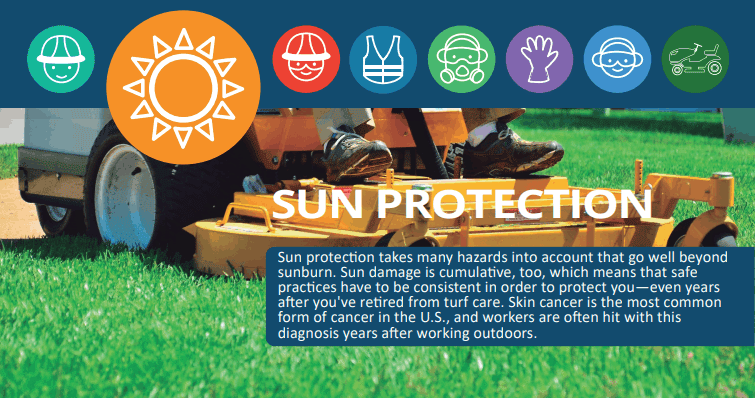
Outdoor workers are exposed to the sun’s rays for extended periods of time, and working outdoors day after day leads to cumulative damage that organizations and workers alike need to take into serious consideration.
In fact, some workers can expect to spend eight hours or more outside every day. Many of these workers enjoy working in the outdoors; there are, however, some vital truths about outside work environments that we all need to understand to keep ourselves and others safe.
Did we hear someone ask, “What about the benefits of sun exposure?” Well, yeah. That’s relevant, too, so we’ll start there.
What are the benefits of sun exposure?
We’ll start by noting that exposure to the sun offers some great health benefits.
1. Time in the sun can reduce hypertension
Many studies have shown that exposure to the sun has the power to lower your blood pressure. And lower blood pressure, in turn, can help to reduce the risk of a multitude of other medical conditions, such as stroke and heart attack.
2. Sunlight also boosts Vitamin D production
The sun’s rays are the number-one natural source of Vitamin D. And this vital vitamin helps to promote healthy bones, and can reduce the risk of osteoporosis, depression, and some cancers.
…And what are the dangers of sun exposure?
As with all great things in life, too much can be dangerous.
Extended lengths of exposure to the sun can be very damaging, in particular for your skin cells.
The sun emits ultraviolet (UV) rays that are known to damage skin cells, down to your skin cell DNA. And excessive exposure to UV rays can cause signs of premature aging, such as wrinkles and many types of skin cancers, including melanoma.
It’s important to note that UV radiation from the sun is just as damaging to your skin cells on overcast days as it is on sunny days. In fact, some experts believe that cloudy days can be more dangerous because many people fail to take precautionary steps because “it’s not that sunny” outside.
These facts make it crucial that all workers spending time outside understand the dangers of excess sun exposure and take the necessary precautionary steps, whether it is cloudy or sunny outside.
First sign of too much sun exposure
The first sign of sun damage that you’re likely to notice is sunburn. Your skin can show the early signs of sunburn in as little as 15 to 30 minutes.
If you’re not careful, sunburn can turn to sun blisters very quickly. These blisters can be quite painful and can appear anywhere on the body, including on your eyes, ears, nose, and lips.
It’s crucial to take appropriate first aid measures at the first sign of sun damage.
Preventive steps to take
Fortunately, there are several steps you can take to protect yourself when working outside before you ever notice symptoms of excess sun exposure. And taking these protective measures can help reduce all the subsequent health risks associated with excessive sun exposure, even years from now.
Sunscreen is one of the most effective tools for preventing sun damage. Use a sunblock product that has a label of SPF 30 (Sun Protection Factor) or higher.
Sunscreen must be applied to all areas of the body that will be exposed to the sun, including your face, eyelids, neck and ears at least 20 minutes before going outside.
You should also reapply sunblock to all areas every two hours. A special sunblock lip protection balm with an SPF 30 or higher should also be applied at least every two hours.
The goal when working outdoors is to wear clothing that leaves the least amount of skin exposed to the sun as possible.
For example, long pants and either a short or long-sleeved shirt work well.
UV rays are so intense that they can actually burn right through loose weave fabrics, too. For this reason, it’s crucial for outdoor workers to choose clothing made with tight weave fabrics, such as cotton.
While the right clothing can protect most of the skin on your body, it’s important not to forget to protect your face and neck. You should consider wearing a wide-brimmed hat to prevent the UV rays from hitting your face and neck area.
No work gear would be complete without the right eyewear, either. Anyone working outdoors should wear sunglasses or other protective eyewear with a UV 40 or higher. Hats and sunglasses are not just for the summer months, either. They should be worn all year long.
Studies show that one in five Americans will develop skin cancer at some point in their lives. Studies also show that taking precautionary steps when working outdoors can significantly reduce the risks associated with excessive sun exposure.
Ultimately, every employee is responsible for taking preventive steps to protect themselves, especially when working in an outdoor or hands-on labor environment.
And it’s your employer’s job to educate you on the dangers of excessive sun exposure as well as on the precautionary steps to take to protect yourself. You can help other workers, too, and keep an eye out for anyone who may not have “gotten the memo” on these crucial safety practices.
